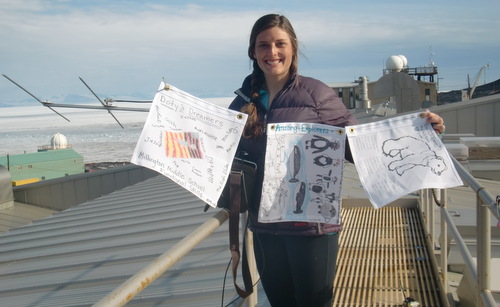This journal is brought to you by...
 Roxanne Beltran - graduate student researcher holding you flags as she scouts for seals. Photo credit: Alex Eilers
Roxanne Beltran - graduate student researcher holding you flags as she scouts for seals. Photo credit: Alex Eilers
- Doty's Dreamers at Millington Middle School
- Ms. Ashmore and her first grade class at Riverwood Elementary
- Ms. N. J. Jones and her 2nd grade class at Berclair Elementary
This post was written by graduate student researcher Roxanne Beltran.
I bet by now you are wondering how we find our seals! There are about 2000 Weddell seals in the population that we study, and each year we are looking for just 24 of those animals – that’s about 1% of the population! Fortunately, we have lots of tools that we can use to easily find our animals. If you read the Tagging/Equipment journal, you are familiar with the flipper tags that we put on the seals! The VHF radio tag has a long antenna on it, so if we ever see a seal with an antenna coming out of its back flippers, we know that she’s our target animal! Believe it or not, we also use Clairol blonde hair dye to “mark” our seals, so that we can easily find them again!
 Here is a picture of one of the hair dye ‘marks’ we used on the seals. Photo credit: Alex Eilers, MMPA Permit # 17411
Here is a picture of one of the hair dye ‘marks’ we used on the seals. Photo credit: Alex Eilers, MMPA Permit # 17411
How do we get around?
In order to find animals that have antenna tags or bleach marks, we need to travel around the ice. With all of the gear that we wear, including heavy bunny boots, it can be hard to walk long distances on the ice! One way that we get around the ice and look for our seals is by snow machine, like the one below:
 This snow machine can tow a sled that carries us and our gear all over the ice! Photo credit: Roxanne Beltran
This snow machine can tow a sled that carries us and our gear all over the ice! Photo credit: Roxanne Beltran
We have to wear lots of hats, gloves, scarves and jackets on the snow machine because it is so cold! Riding on the snow machine at 20 miles per hour is similar to having 20 mile per hour winds – so wind chill can bring the temperatures well below freezing!
When the ice starts to melt in January, we often take helicopters out to find our seals. The helicopters look just like this:
 This helicopter helps get us to place we can’t get to by snow machine because the ice is melting. Photo credit: Roxanne Beltran
This helicopter helps get us to place we can’t get to by snow machine because the ice is melting. Photo credit: Roxanne Beltran
Remember the hand-held antenna from the tagging journal that helps us hear the pinging tags on our seals? We put a similar (but much larger!) antenna on the helicopter. We fly around and listen for pinging sounds. As soon as we hear one of our seals through the antenna, the helicopter pilot flies in circles until we get a better idea of where exactly the seal is. Then, the helicopter pilot lands and we walk around until we find the seal.
We really enjoy taking the helicopter out because it helps us to get a better idea of the area. In Antarctica, the ice changes VERY quickly, so it is important for us to always know where the big cracks and crevices are – especially when we are snow machining.
 Ice image of McMurdo Sound on January 6. Photo credit: Rapid Response
Ice image of McMurdo Sound on January 6. Photo credit: Rapid Response

Comments